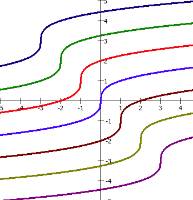Summary
Students will be able to identify the family to which a function belongs using properties like maximum and minimum points, intercepts, asymptotes, and symmetry.
Essential Question(s)
What is a family of functions? How can we identify the family a function belongs to?
Snapshot
Engage
Students will relate verbal descriptions of phenomena to graphs by writing brief descriptions of events that could be illustrated by a given graph.
Explore
Students will sort a stack of graph cards, looking for similarities and differences between the graphs in order to explore families of functions and properties of functions like intercepts, asymptotes, maximums, and minimums.
Explain
Students will explain how they sorted the cards will be introduced to vocabulary that will help them to better describe the criteria they used to sort.
Extend
Based on a story, students will draw graphs and identify the properties of their graphs as well as the family of functions to which the graphs belong.
Evaluate
Students will create a graphic organizer summarizing what they have learned. This graphic organizer can be referenced any time properties of functions are studied in class.
Materials
Function cards (attached)
Tonya's Travels
Function Stories (attached)
Engage
This is a great lesson to use at the beginning of algebra two, before students begin to study any of the specific kinds of functions (parabolic, radical, rational, absolute value, exponential, logarithmic, etc.) or transformations. This Engage activity should activate students' prior knowledge about graphs from algebra one.
On a Smart Board, document camera, or by making copies, display "Tonya's Travels" (found under Attachments) to students. Ask students to work in pairs to answer the questions below the graph.
Review the questions, asking a different pair to answer and explain their reasoning for each of the five questions. As students explain their reasoning, be careful to ensure that they are using proper mathematical vocabulary like point, segment, constant, increasing, and decreasing. Remind them of these vocabulary words as needed.
After all of the questions have been reviewed, discuss what the labels on the axes should be. Given what we know about the graph, the independent axis should measure time, and the dependent axis should measure distance. However, allow your students to think of different units of time (seconds, minutes, hours) and distance (inches, feet, miles) to determine which they feel are the most appropriate units for the graph. There is no correct answer. However, the class should come to an agreement about how to label the graph. Once the class has come to a consensus about what the units should be, have students consider the different ways Tonya could have traveled on Saturday (walking, running, biking, by car, swimming, etc.—let the students be as creative as they wish). Ask students to work in groups to consider by what means Tanya might have traveled during each time interval on the graph that showed motion.
After each group has discussed the possibilities, ask them to share their conclusions.
Explore
Explain to students that they will be examining many different kinds of graphs in class. To be able to describe graphs efficiently, they will need to categorize graphs, just like shapes can be categorized by their dimensions, number of sides, or angle properties. Group students into pairs or groups of three and distribute one set of graph cards to each pair, graph-side up. Tell students to sort the cards into sets in any way they wish, as long as they follow the rules below:
Each set must have more than one card in it
Each card in a set must share a single characteristic. For example, they are all lines, or they all contain the point (0,1) among other things.
No card may belong to more than one set.
Explain
Taking turns, have each group bring a set of their sorted cards to the front. Have them place their cards under the document camera and explain what all of their graphs have in common. Ask students to confirm that these cards all have this common characteristic and that there are no other cards that share the characteristic. If the class agrees that the group has found a correct set, have the group flip their cards over to display the equations of the graphs on the back. Ask the class what the equations have in common and what conclusions they can form based on their observations. Ask students to write down the conclusion they formed as an if-then conditional statement.
Possible conclusions should definitely include (but are not limited to) the following:
If it is a U-shaped graph, then x is being squared in the equation of the function.
If it is a V-shaped graph, then the equation of the function contains absolute values.
If the graph is S-shaped, so that the bend is almost vertical, then there is a cube root in the equation of the function.
If the graph is S-shaped, so that the bend is almost horizontal, then there is a cube in the root of the equation of the function.
If the graph has an endpoint (continues on in only one direction), then the equation of the function contains a square root.
If the graph becomes almost horizontal at one end, then the equation of the function contains a power of 2.
If the graph becomes almost vertical at one end, then the equation of the function contains log base 2.
As you discuss student conclusions, introduce or reinforce vocabulary that will allow students to state their conclusions more precisely. For example, if students discuss the graphs that "become almost vertical," you can define the concept of a vertical asymptote for them and reword their conclusion using this vocabulary. You would help them reword it to something more along these lines: "If the graph has a vertical asymptote, then then equation of the function contains log base 2."
After the associated vocabulary has been defined, record student conclusions on the board or on a flip chart using precise mathematical language, which may include endpoint, end behavior, intercepts, horizontal or vertical asymptotes, maximum, minimum, turn, or critical point.
Once students have formed all seven conclusions listed above, have students re-sort the cards according to those conclusions. Tell students that each group they have created represents one family of functions. Ask students to work with their groups to define what a family of functions is. After several minutes, ask for volunteers to share their answers. Tell the class that you want to make one class definition for a family of functions and discuss with students what this definition should be, questioning them as necessary until a sufficiently precise definition is formed.
Tell students that each family they formed has one parent function. Ask students to look at the equations (not the graphs) in each group and see if they can determine which equation is the parent equation. Give students several minutes to think about this.
After several minutes, ask students to volunteer definitions of what a parent function may be. Again, discuss the definition and question students until a sufficiently precise definition of parent function is created. Once a definition is created, have students pull the parent function out of each group. They should keep the parent functions on their desk for the Extend activity, but the remainder can be put back at this point in the lesson.
Extend
Distribute the attached "Function Stories" handout, and have students complete it in class or at home. Check their results with a partner at the beginning of the next class. Depending on how students interpret the stories, multiple answers are possible. For example, for story two, if students place time along the x-axis and height along the y-axis, they should model a quadratic equation. However, if they reverse the axes, then they will model a square root function. This and similar situations would be a good opening to discuss independent and dependent variables with your students.
Evaluate
Pass out four pieces of paper to each student. They can be all white, one color, or multiple colors, as shown below. Have them complete the process below to create a foldable graphic organizer, or foldable.
Along the top, label each column of the foldable as follows:
family of functions
parent function
sketch of parent function
intercepts of parent function
asymptotes of parent function
turning points of parent functions
end behavior of parent function
other notes
If you have not yet discussed the concepts above and introduced this vocabulary, do so as you have them label their foldables.
Under the first row, which should already be labeled family of functions, and down the column closest to the fold, label each row as follows. As you name each function, show students the sketch of the parent function. Have students copy the equation and graph of each parent function into the appropriate space of the foldable.
quadratic
square root
cubic
cube root
exponential
logarithmic
absolute value
When this is complete, foldables should look like the one below:
Have students fill in the remaining tabs on the rest of the foldable. This activity should act as a formative assessment, allowing you to identify what information that have learned from the activity and what information about parent graphs still needs to be learned. Therefore, do not supply students with the information needed on these tabs.


